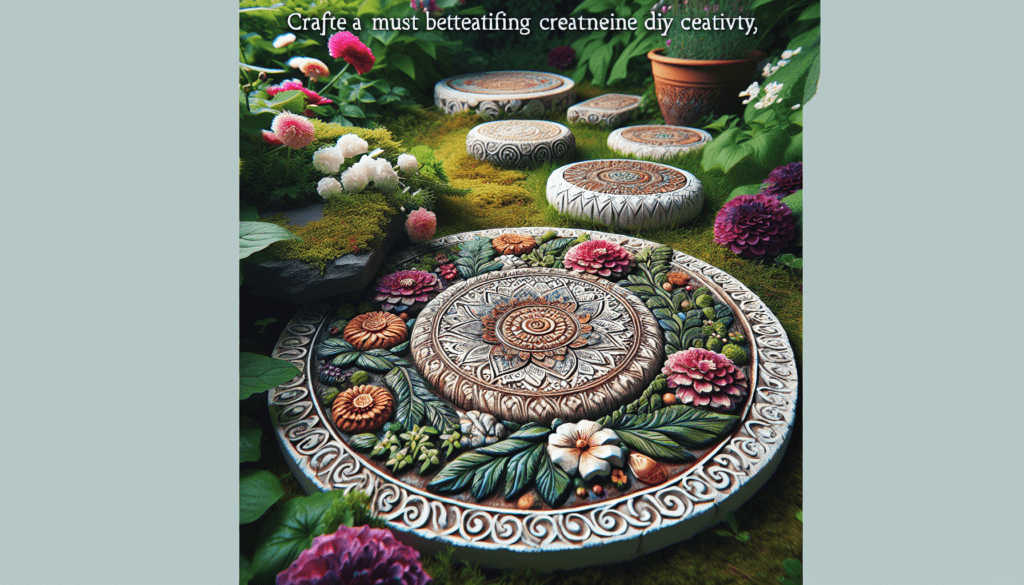Imagine stepping out into your backyard and being greeted by a beautiful path of personalized stepping stones leading you through a lush garden oasis. With just a few simple materials and a bit of creativity, you can create your own garden stepping stones that will add a touch of charm and uniqueness to your outdoor space. In this article, we will show you step-by-step how to make your own garden stepping stones, allowing you to unleash your inner artist and transform your garden into a whimsical wonderland.

Choosing the Design and Materials
Selecting the Right Design
When it comes to making your own garden stepping stones, choosing the right design is crucial. You want to create a pathway that not only complements the overall aesthetic of your garden but also suits your personal style. There are numerous design options to consider, such as round, square, or irregularly shaped stepping stones. Take some time to browse through different designs and envision how they would enhance the beauty of your garden.
Choosing the Type of Stepping Stones
Once you’ve decided on a design, it’s time to choose the type of stepping stones you want to create. There are various materials you can use, including concrete, mosaic, or even natural stones. Concrete stepping stones are a popular choice due to their durability, affordability, and versatility. On the other hand, mosaic stones add a touch of artistic flair to your garden, allowing you to unleash your creativity. Natural stones offer a more rustic and organic look, perfect for those who appreciate a more naturalistic garden style.
Gathering the Necessary Materials
Before you can start creating your garden stepping stones, it’s essential to gather all the necessary materials. For concrete stepping stones, you’ll need items such as concrete mix, water, a mold (which can be bought or made using materials like cardboard or wood), and optional reinforcement materials like wire mesh or fiberglass. If you choose to make mosaic stepping stones, you’ll additionally need mosaic tiles or glass pieces, adhesive, and grout. For natural stone stepping stones, you’ll need stones of various sizes, mortar, and sand. Take the time to gather all the materials beforehand to ensure a smooth and efficient DIY process.
Preparing the Area
Clearing the Pathway
Before you can start laying down your stepping stones, it’s important to clear the pathway of any obstructions. Remove any weeds, rocks, or debris from the area to create a clean and even surface. This step will ensure that your stepping stones sit flat and securely in place.
Leveling the Ground
To ensure the stability of your stepping stones, it’s crucial to level the ground where they will be placed. Use a rake or shovel to remove any unevenness and create a smooth and level surface. This step will prevent your stepping stones from shifting or tilting over time.
Measuring and Marking the Placement
Once the ground is leveled, measure the distance between each stepping stone to ensure proper spacing. Use chalk or a marker to mark the desired placement of each stone. This step will help you maintain a consistent and visually appealing pathway.
Mixing and Pouring the Concrete
Calculating the Correct Amount of Concrete
If you’ve chosen to create concrete stepping stones, it’s essential to calculate the correct amount of concrete needed. Refer to the instructions on your concrete mix package to determine the correct water-to-concrete ratio. Multiply this ratio by the number of stepping stones you plan to make to ensure you have enough concrete for the project. It’s always better to have a little extra than to run out in the middle of pouring.
Mixing the Concrete
Once you have the correct amount of concrete mix, it’s time to mix it according to the package instructions. Use a wheelbarrow, large bucket, or a mixing tray to combine the concrete mix with water. Stir the mixture thoroughly until it reaches a smooth and consistent texture. Be sure to follow the safety instructions provided by the concrete mix manufacturer, such as wearing gloves and protective eyewear.
Adding Reinforcement if Desired
For added strength and durability, you may choose to add reinforcement materials to your concrete stepping stones. This step is particularly important if you plan to create larger or irregularly shaped stones. Wire mesh or fiberglass can be placed in the mold before pouring the concrete to provide extra reinforcement.
Pouring the Concrete into the Mold
Once the concrete mixture is ready and any optional reinforcement is in place, it’s time to pour the mixture into the mold. Start by evenly distributing the mixture and filling the mold to the desired thickness. Use a trowel or a piece of wood to smooth the surface and remove any air bubbles. Remember to follow the instructions on the concrete mix package regarding curing and drying times.
Decorating the Stepping Stones
Adding Decorative Items to the Concrete
If you want to add a personalized touch to your stepping stones, consider adding decorative items to the wet concrete. You can embed small pebbles, glass beads, ceramic tiles, or even seashells into the surface of the stone. Arrange them in patterns or create a mosaic design for a visually stunning effect.
Creating Patterns or Designs
Another way to enhance the aesthetic appeal of your stepping stones is by creating patterns or designs on the surface. You can use a stick or a soft brush to create lines, swirls, or geometric shapes. Let your creativity guide you and experiment with different techniques to achieve the desired effect.
Embedding Personalized Items
For a truly personalized touch, consider embedding special items into the wet concrete. You can add your children’s handprints, paw prints of your beloved pets, or even small trinkets with sentimental value. These personalized elements will make your garden stepping stones truly unique and meaningful.

Curing and Drying the Stones
Covering the Stepping Stones
To promote proper curing and drying, it’s important to cover your stepping stones. Use plastic sheets or trash bags to create a protective cover over the stones. This step helps retain moisture and ensures a more controlled drying process.
Allowing Sufficient Curing Time
The curing time for concrete stepping stones typically ranges from 24 to 48 hours. However, it’s crucial to follow the instructions provided by the concrete mix manufacturer. Ensure that the stones are kept in a warm and dry area during the curing process. Avoid placing any weight or pressure on the stones until they are fully cured.
Removing the Stones from the Mold
Once the stepping stones are fully cured, it’s time to remove them from the mold. Carefully turn the mold upside down and gently tap the back to release the stone. If the stone doesn’t come out easily, you can use a rubber mallet or a piece of wood to gently loosen it. Be patient and take care not to damage the stone during this process.
Placing the Stepping Stones
Prepping the Pathway
Before laying down your stepping stones, it’s a good idea to prepare the pathway. Remove any remaining debris and ensure that the ground is clean and level. This step will provide a stable base for the stones and ensure that they sit securely.
Laying the Stones in Position
Take your time to lay each stepping stone in its designated position. Pay attention to the spacing and alignment, ensuring that the stones are evenly placed along the pathway. Gently press down each stone to help it settle into place.
Ensuring Proper Spacing and Alignment
To create a visually pleasing and functional pathway, it’s important to ensure proper spacing and alignment between the stepping stones. Use a ruler or a measuring tape to maintain consistent distances between each stone. Check and adjust the alignment as needed to ensure a smooth and comfortable walking experience.

Sealing and Protecting the Stones
Cleaning the Stones
Once the stepping stones are in place, it’s important to clean them to remove any leftover debris or residue. Use a brush or a soft cloth to gently scrub the surface of each stone, taking care not to damage any embedded decorative items.
Applying a Sealer or Protector
To protect your stepping stones from weathering and wear, consider applying a sealer or protector. This step will enhance the durability of the stones and make them easier to clean and maintain. Follow the instructions provided by the sealer manufacturer and allow sufficient drying time before using the pathway.
Maintaining and Caring for the Stepping Stones
Regular maintenance and care are crucial to keeping your garden stepping stones in optimal condition. Sweep the pathway regularly to remove dirt, leaves, or other debris. If stains occur, clean the stones using a mild detergent and water. Apply a fresh coat of sealer periodically to ensure long-lasting protection and beauty.
Alternative Methods
Using Stepping Stone Kits
If you’re looking for a quicker and easier approach, consider using stepping stone kits. These kits provide pre-made molds, concrete mix, and sometimes even decorative items. They offer a convenient solution for those who prefer a more straightforward DIY experience or have limited time.
Creating Stepping Stones with Hypertufa
Hypertufa is a lightweight and durable material that resembles natural stone. It is made from a mixture of cement, perlite, and peat moss. Creating stepping stones with hypertufa allows you to achieve a natural and rustic look without the weight of real stone. There are numerous hypertufa recipes and techniques available online, making it a versatile and customizable alternative.
Crafting Stones from Natural Materials
For a truly unique and organic look, consider crafting your stepping stones from natural materials. Use large, flat stones as the base and arrange smaller stones or pebbles on top to create a mosaic-like effect. This method allows you to incorporate the beauty of nature directly into your garden pathway.

Safety Considerations
Wearing Protective Gear
When working with concrete or other materials, it’s important to prioritize safety. Wear protective gear such as gloves, goggles, and a face mask to protect yourself from potential hazards. Concrete mix can be caustic, so it’s crucial to prevent skin and eye contact.
Working in a Well-ventilated Area
To minimize the inhalation of dust or fumes, it’s advisable to work in a well-ventilated area. If you’re working indoors, open windows or use fans to ensure adequate air circulation. This precaution will help maintain a safe and healthy environment during the DIY process.
Handling Concrete Safely
Concrete mix contains chemicals that may cause skin irritation or allergic reactions. Follow the instructions provided by the manufacturer to handle the concrete safely. Avoid direct contact with the skin and eyes, and wash off any spills or splashes immediately with clean water. Keep concrete mix out of reach of children and pets.
Conclusion
Creating your own garden stepping stones is a fulfilling and enjoyable DIY project that allows you to add a personal touch to your outdoor space. By carefully choosing the design and materials, preparing the area, mixing and pouring the concrete, and adding decorative elements, you can create beautiful and functional stepping stones for your garden. Remember to follow safety considerations and alternative methods, and take proper care and maintenance to ensure the longevity and beauty of your stepping stones. So grab your materials, get creative, and start building your dream garden pathway today!



